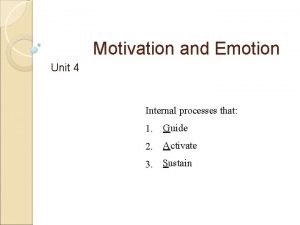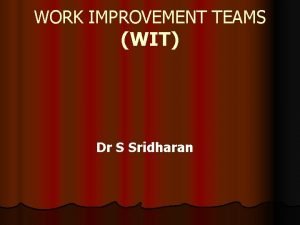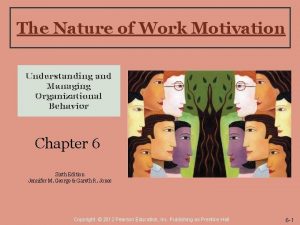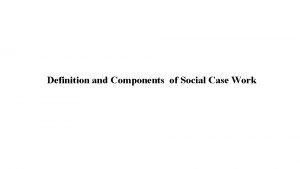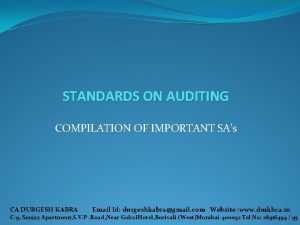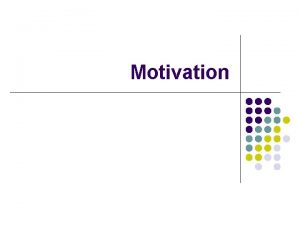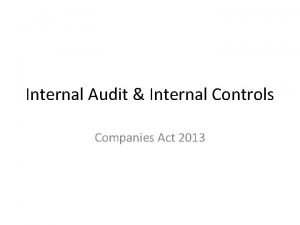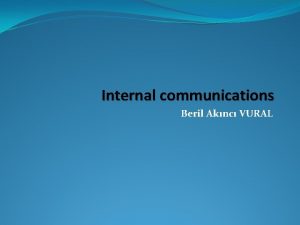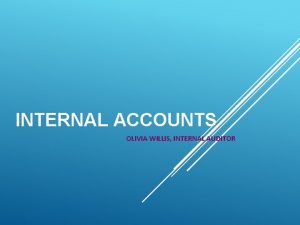Work Motivation Work Motivation n Definition n Internal












- Slides: 12

Work Motivation

Work Motivation n Definition n Internal State that directs individuals to certain goals and objectives n n Not directly observable Inferred from behavior § variability in behavior is not result of § differences in ability § situational (environmental) factors

Work Motivation n Theories of Work Motivation n Internal (Content) Theories n n Identify factors within an individual that energize, direct, sustain, and stop behavior. External (Process) Theories n Describe how personal and situational (environmental) factors interact and influence each other to produce certain kinds of behavior

MASLOW’S HIERARCHY OF NEEDS ACTUALIZATION ESTEEM SOCIAL SAFETY PHYSICAL

Mc. Clelland’s Learned Needs n Need for Achievement n a need to accomplish goals, excel, and strive continually to do things better. n Need for Affiliation n desire for friendly and close interpersonal relationships § affiliative interest § affiliative assurance n Need for Power n the need to influence and lead others and be in control of one’s environment § socialized power § personalized power

Equity Theory We. Larry are motivated by perceived inequity (unfairness) Moe Curly Perceived inequity creates a state of “unpleasant” z z z tension that we are motivated to reduce How do we perceive inequity (unfairness)? According to Adams, inequity is perceived when our perception of the ratio of our Inputs to Outputs is different from that of a comparison other. – amount of An. Inputs example: work, KSAs, experience Outputs – pay, promotions, perqs

Reducing Inequity n Change your inputs n Change your outputs n Change your comparison other n Alter your perceptions

Expectancy Theory Valence - attractiveness of the outcomes to employees Instrumentality - strength of belief that Job outcomes pay, ofpromotions) performance results in outcome Expectancy - (e. g. , strength belief that effort attainment will result in successful performance

Expectancy Theory (Vroom, 1964) n Five Components n Job outcomes (e. g. , pay, promotions) n Valence - attractiveness of the outcomes to employees n Instrumentality - strength of belief that performance results in outcome attainment n Expectancy - strength of belief that effort will result in successful performance n Force - amount of pressure within the person to be motivated


Goal Setting Theory n Function of Goals n basis of motivation n direct behavior n For goals to be effective § individuals must be aware of goals § must accept the goals n Factors that influence effectiveness of goal setting § goals must be specific § goals should be difficult but attainable

Herzberg’s Two Factor Theory Hygiene Factors salary company policy physical facilities administration working conditions co-worker relations Motivators challenge autonomy advancement recognition
 Motivation is an internal process
Motivation is an internal process Elements of internal control system
Elements of internal control system Features of vouching
Features of vouching Motivation work improvement team
Motivation work improvement team Nature of work motivation
Nature of work motivation Case-work définition
Case-work définition Conflict of animal farm
Conflict of animal farm Audit is important
Audit is important Sports psychology definition
Sports psychology definition Objective motivation
Objective motivation Definition of motivation
Definition of motivation Defination of motivation
Defination of motivation Instinct theory of motivation
Instinct theory of motivation
